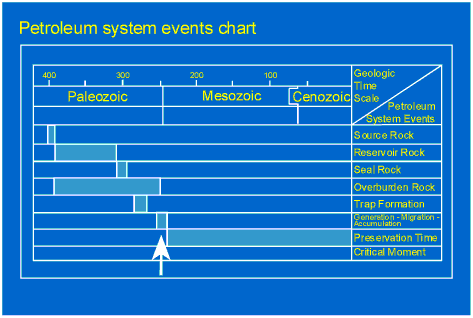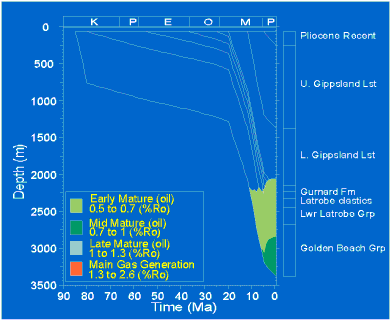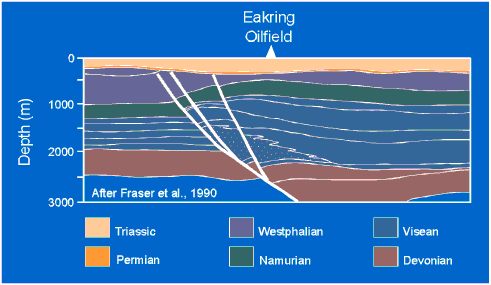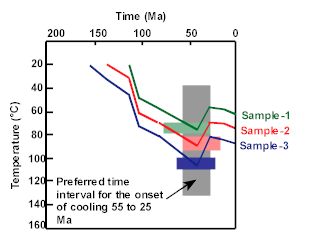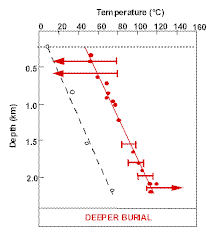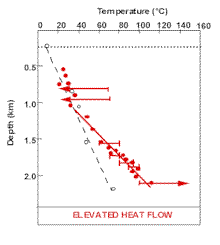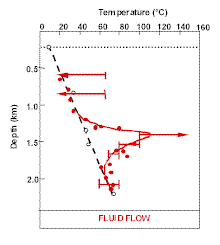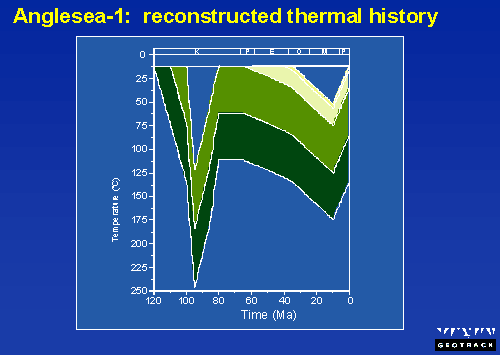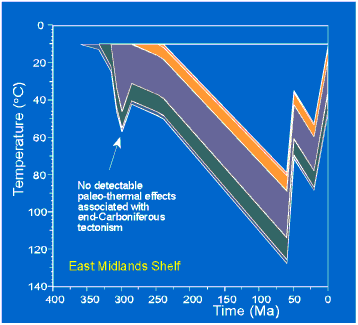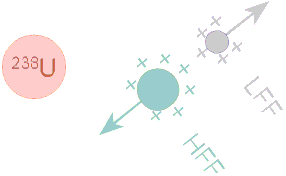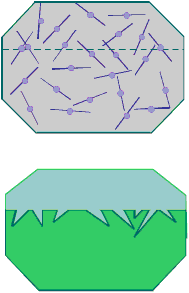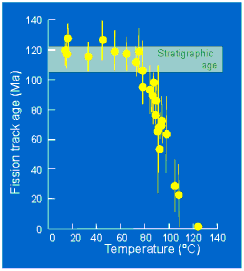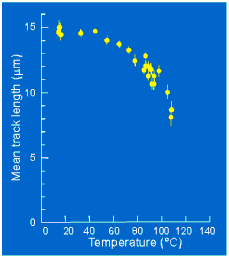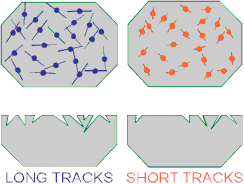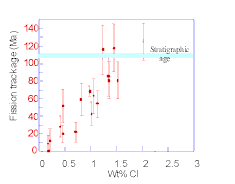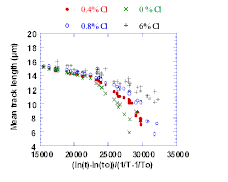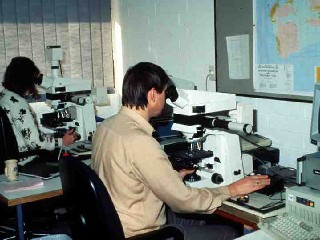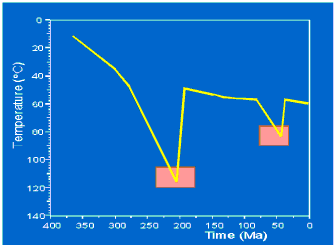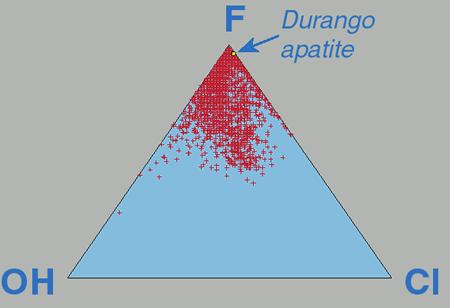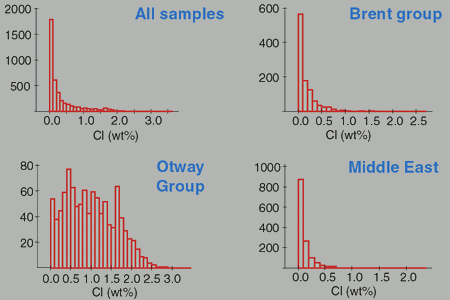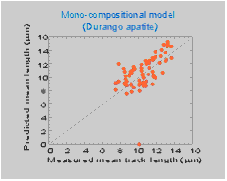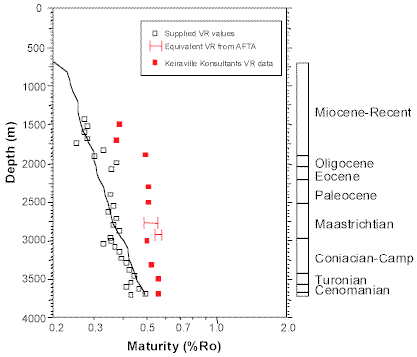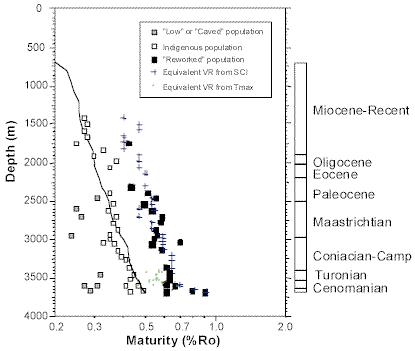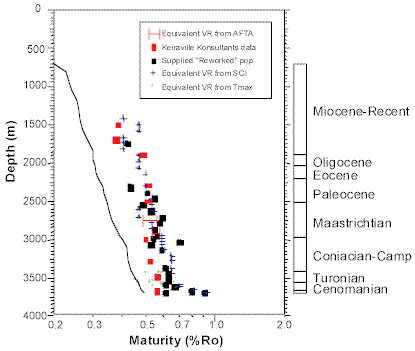 |
 |
 |
 |
 |
 |
||
 |
|||||||
Thermal history in hydrocarbon exploration
Various factors are widely recognised as important aspects of hydrocarbon exploration, e.g.
- source rock
- maturity
- migration
- reservoir
- trap
Another important factor is the timing of hydrocarbon generation in relation to the time at which structures were formed, which is a central aspect of the concept of the "Petroleum System".
Petroleum system: basic concept
"The essential elements (source rock, reservoir, seal, overburden) and processes (trap formation, generation-migration-accumulation of petroleum) must occur in time and space so that organic matter in a source rock can be converted to a petroleum accumulation." Magoon and Dow, 1994, AAPG Memoir 60
For simple histories reconstructing the history of hydrocarbon generation through time is relatively straightforward, as illustrated by this example from the Gippsland basin.
But in other cases, the situation is less straightforward. The section intersected in the Anglesea-1 well (Otway Basin) contains two unconformities. Source rocks within the Cretaceous section are within the oil window, but when was the oil generated?
How do we reconstruct a complete history when the preserved section is incomplete? An example from the onshore UK.
Thermal History Reconstruction (THR)
THR relies on application of Apatite Fission Track Analysis (AFTA®) and Vitrinite Reflectance (VR) to:
- identify the timing of dominant episodes of heating and cooling that have affected a sedimentary section
- quantify the paleotemperatures through the sequence
- and then to characterise the mechanisms of heating and cooling
Constrained Basin Modelling
THR relies on measured thermal history parameters to reconstruct a more complete thermal, maturation and burial / uplift history
In this way, the history of hydrocarbon generation can be assessed within a consistent framework, constrained by measured data.
This approach provides firm constraints which must be honoured by any viable basin model - Constrained Basin Modelling
Applying this approach to the Anglesea-1 well reveals that Early Cretaceous source rocks began to cool from maximum paleotemperatures between 110 and 95 Ma. We can also detect a later event.
In wells from the East Midlands of England we find that Carboniferous source rocks began to cool from maximum paleotemperatures in the Early Tertiary (between 65 and 50 Ma). A later cooling episode is also revealed.
Apatite fission track analysis (AFTA®)
Key points:
Based on analysis of radiation damage trails ("fission tracks") within detrital apatite grains (extracted from sandstones and other clastic rocks)
Each fission track is created by spontaneous fission of a single atom of 238U
Fission tracks can be selectively dissolved and enlarged by etching in dilute nitric acid
Etched spontaneous fission tracks in an apatite crystal.
Fission track age
The number of tracks in an apatite grain depends on:
- uranium content
- time
Therefore in principle, if we measure the uranium content and the number of tracks, we can measure the time over which tracks have accumulated - the fission track age
But if we measure fission track ages in sub-surface samples, we find that at temperatures greater than ~70°C, the ages are progressively reduced to zero at around 120°C.
Track length
The reduction in fission track age arises because the radiation damage constituting each fission track is progressively repaired, at a rate which increases with temperature. This repair is manifested as a decrease in the length of individual tracks.
The proportion of tracks intersecting the polished surface of an apatite grain depends on the track length, and therefore as track length is progressively reduced, so is the fission track age.
Confined tracks in apatite.
Compositional effects
Single grain fission track ages in a sample from a present-day temperature of ~95°C show a clear and consistent variation with Cl content:
Chlorine content exerts a significant control on fission track annealing rates in apatite, as also seen in laboratory experiments:
Apatite fission track analysis (AFTA®)
AFTA is based on three types of measurement:
- fission track age
- confined track lengths
- chlorine content
Cl content is measured in every grain in which either age or length data is collected. Grain locations are recorded using computer-controlled microscope stages, and archived for future reference.
By modelling AFTA parameters through likely thermal history scenarios, we can define the range of temperature-time conditions giving predictions which are consistent with the observed data.
Importance of chlorine content
Common detrital apatite grains in sedimentary rocks from around the world show significant variation in chlorine content, both within individual samples and between different samples.
Apatite compositions - Ternary plot 4172 grainsThe kinetic model used to extract temperature-time solutions from our AFTA data explicitly takes into account the effect of Cl content on annealing rates.
Calibration of this kinetic model against data from simple geological situations confirms the validity of the model.
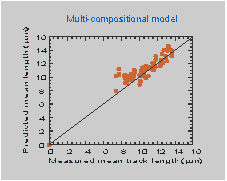
Use of a kinetic model that does not take compositional effects into account (above right) provides a very poor match with the calibration data.
Vitrinite Reflectance
The kinetic response of VR, as expressed in the Burnham and Sweeney (1989) model is very similar to the kinetics of fission track annealing in durango apatite.
The Burnham and Sweeney (1989) kinetic model has been calibrated against data from similar geological situations, in similar fashion to AFTA.
Integration of AFTA and VR is useful in a number of ways, e.g.:
- providing independent verification of paleo-thermal effects
- extending information from AFTA to units dominated by fine-grained lithologies
- identifying multiple paleo-thermal episodes
Potential pitfalls in using VR data
VR data from different laboratories vary appreciably in quality and reliability. Our experience suggests that attribution of modes - e.g. caved, indigenous and re-worked, solely from the data is often erroneous. VR data produced on the basis of identifying the indigenous vitrinite population on petrographic grounds provides the most reliable data.
The results on the right are from a recent Geotrack study. VR data supplied by a client suggest all units throughout the well are currently at their maximum temperatures, whereas AFTA and new VR data suggest that most units have been hotter in the past.
Further investigation of the original VR dataset revealed a number of populations within the measurements, as shown on the right, including a population of higher reflectances, originally interpreted as "re-worked" vitrinite, and a lower reflecting population attributed to caved material. Equivalent maturity values from SCI and Tmax data are highly consistent with these "re-worked" vitrinite values.
The new VR values, the equivalent maturity values from AFTA, SCI and Tmax data and the "re-worked" vitrinite values from the original dataset reveal a well-defined trend, as shown on the right, consistently higher than the values originally attributed to the indigenous population. Thus, these original values are clearly too low and values originally designated as "reworked", together with the AFTA, SCI and Tmax values, provide the most reliable indication of true maturity levels in this well.
Similar observations are remarkably common, and illustrate a general tendency amongst many geologists to underestimate the importance of exhumation (or deeper burial). Thus, the reflectance population closest to the value expected on the basis of the preserved section is most commonly identified as the indigenous population. These observations highlight the importance of combining information on palaeo-thermal effects from different techniques, in order to provide a more objective assessment.
The occurence of three separate sub-parallel trends denoting caved, in-situ and re-worked vitrinite, as in the earlier analyses illustrated here, is highly unlikely, and more likely arises because of measurement of macerals other than true vitrinite. The occurrence of three sub-parallel trends is usually a reliable sign of maceral misidentification.
